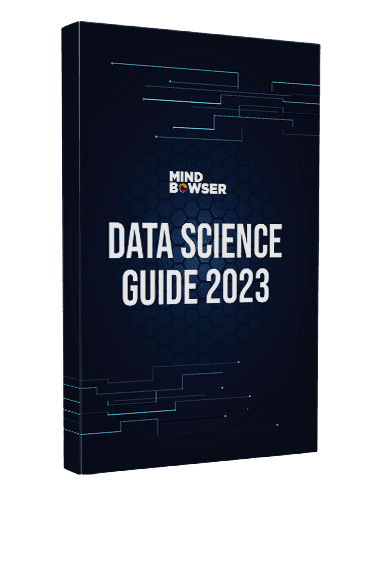Data is only as useful as the strategy you have for it. Just gathering and storing data won’t give you an advantage. You need a plan and a specific strategy for what you want to do with it to avoid becoming overwhelmed by the volume and complexity of data.
Investing in data science can be extremely beneficial for business if done correctly. Having a data science strategy in place will allow you to build an effective data science team, have a great data architecture, and know how to approach the commercial aspects of data science the right way.
Knowing where to look for data, extracting valuable insights, and utilizing the data are all crucial parts of a successful data science strategy.
In this guide, we’ll walk you through a 7-step framework to build a data science strategy that aligns with your business goals and ensures success.
Data science is the business’s plan to use data to achieve its goals. The data science strategy helps create a data-driven culture within an organization and obtain the skills and knowledge needed to make it happen.
The data science strategy elements must work together to achieve great results. Therefore, you must use them wisely to create a strong and successful strategy.
Data is only as useful as the strategy you have for it. Once you understand the significance, the next step is to weave together a plan that transforms raw data into a powerful asset.
Here are 7 simple ways to build an effective data science strategy.
You must ask yourself your goals to make data science successful for your business. What do you want to achieve? All companies want to generate more revenue but have different paths. Data science can help you achieve your goals more efficiently depending on your business decisions.
You must set a measurable goal to get the most out of data science. However, with such goals, you can track your progress and see how data science benefits your business. Having a measurable goal develops a sense of understanding about what can be done with the data you collect and the insights you glean from it.
Related Read: How To Use Data Science Consulting For Business Growth?
It’s always a great idea to find a vendor to partner with who will understand your business, objectives, and project requests. Soon, you will need to find a vendor who is experienced in your industry and can help you build a successful strategy for your business in the US.
Furthermore, the chosen vendor must prioritize communication and be dedicated to your project. Finally, as your progress in developing your data science strategy, you must be mindful of selecting a vendor who continuously strives for growth and has the required skill set in the strategic data science industry.
Related Read: Data Science Consulting: From Idea To Deployment
Tools are only part of your need for a successful data science strategy. You also need to track key metrics to prioritize return on investment and long-term value.
Where to begin? Here are a few metrics we recommend following based on our experience working with customers in US;
By tracking component reuse as a key performance metric, data science teams can demonstrate the effectiveness of their work beyond a single model. In addition, when data science teams create and publish widely used components, like customer datasets or data diagnostic tools, it accelerates the production and deployment of future models.
By standardizing templates, easily accessing and reusing high-value data, and preserving effective software configurations, teams can work smarter and generate results that they can have more confidence in.
Component reuse affects a project’s productivity for future use cases and creates value even after its original use case is completed.
Productivity doesn’t just come down to the number of models you create. To show that you are being productive as a data scientist, you need to set targets and measure your productivity in various ways. This way, you can demonstrate that you are not wasting time just because you don’t deploy a new model daily.
Collecting feedback from users is important to assess whether models in production have their intended impact. Gaining feedback can help answer questions such as; has the model allowed stakeholders to achieve their goals?
Has the model reduced customer churned? By hearing directly from those who use the model, product managers can make informed decisions about how to evolve the model in the future.
Use-case-driven goals are developed entirely around a specific use case. They are designed to help you achieve a particular goal and can be measured so that you can track your progress. Goals that focus on operational milestones rather than long-term strategy are easier for your team to achieve daily.
This way, they can see how their work directly impacts the company’s success. By setting and reaching short-term goals, your team will stay motivated and focused on the ultimate goal. Use different metrics to keep track of the team’s progress and ensure every team member is working towards the same goal.
Data scientists always experiment with open-source and cloud technologies to see what works best for their needs. As data scientists, it’s important to ensure your team has access to the right platforms, tools and infrastructure to succeed in their experiments.
Cloud technologies are great for exploration, but when it comes to products, you must ensure you have a platform designed to scale and grow with the enterprise.
In every data science strategy, you must identify the cross-cutting issues related to technology and software requirements that are common across all use cases. The strategy must also determine what technology is needed to collect data, store it, process it and communicate insights.
You may already have the software required for all these processes. However, you may invest in new software depending on your specific needs. Using technology to collect and retrieve data quickly and efficiently is a huge competitive advantage for companies. Ensure your tech stack provides your team with the tools and resources to use machine learning effectively.
Developing a strategy is incomplete without having a roadmap. You need to set priorities, work on some aspects of the plan, and use them as building blocks. Doing so will help you estimate the timeline to execute the project and how you can communicate the priorities to those involved.
For a good project roadmap, you need the following;

We hope this blog post has provided you with a roadmap for building a data science strategy for your organization. By following these seven essential steps, you can ensure that your data science projects are aligned with your business goals and that you are making the most of your data assets.
If you are looking for help with building your data science strategy, Mindbowser is a leading data science consulting company that can help you achieve your goals. We have a team of experienced data scientists who can help you with everything from data collection and analysis to model development and deployment.
Contact us today to learn more about how we can help you build a data science strategy that will drive business value.

Free Data Science eBook – A Complete Guide
Leave your competitors behind! Become an EPIC integration pro, and boost your team's efficiency.
Register Here

The Mindbowser team's professionalism consistently impressed me. Their commitment to quality shone through in every aspect of the project. They truly went the extra mile, ensuring they understood our needs perfectly and were always willing to invest the time to...

CTO, New Day Therapeutics

I collaborated with Mindbowser for several years on a complex SaaS platform project. They took over a partially completed project and successfully transformed it into a fully functional and robust platform. Throughout the entire process, the quality of their work...

President, E.B. Carlson

Mindbowser and team are professional, talented and very responsive. They got us through a challenging situation with our IOT product successfully. They will be our go to dev team going forward.

Founder, Cascada

Amazing team to work with. Very responsive and very skilled in both front and backend engineering. Looking forward to our next project together.

Co-Founder, Emerge

The team is great to work with. Very professional, on task, and efficient.

Founder, PeriopMD

I can not express enough how pleased we are with the whole team. From the first call and meeting, they took our vision and ran with it. Communication was easy and everyone was flexible to our schedule. I’m excited to...

Founder, Seeke

Mindbowser has truly been foundational in my journey from concept to design and onto that final launch phase.

CEO, KickSnap

We had very close go live timeline and Mindbowser team got us live a month before.

CEO, BuyNow WorldWide

If you want a team of great developers, I recommend them for the next project.

Founder, Teach Reach

Mindbowser built both iOS and Android apps for Mindworks, that have stood the test of time. 5 years later they still function quite beautifully. Their team always met their objectives and I'm very happy with the end result. Thank you!

Founder, Mindworks

Mindbowser has delivered a much better quality product than our previous tech vendors. Our product is stable and passed Well Architected Framework Review from AWS.

CEO, PurpleAnt

I am happy to share that we got USD 10k in cloud credits courtesy of our friends at Mindbowser. Thank you Pravin and Ayush, this means a lot to us.

CTO, Shortlist

Mindbowser is one of the reasons that our app is successful. These guys have been a great team.

Founder & CEO, MangoMirror

Kudos for all your hard work and diligence on the Telehealth platform project. You made it possible.

CEO, ThriveHealth

Mindbowser helped us build an awesome iOS app to bring balance to people’s lives.

CEO, SMILINGMIND

They were a very responsive team! Extremely easy to communicate and work with!

Founder & CEO, TotTech

We’ve had very little-to-no hiccups at all—it’s been a really pleasurable experience.

Co-Founder, TEAM8s

Mindbowser was very helpful with explaining the development process and started quickly on the project.

Executive Director of Product Development, Innovation Lab

The greatest benefit we got from Mindbowser is the expertise. Their team has developed apps in all different industries with all types of social proofs.

Co-Founder, Vesica

Mindbowser is professional, efficient and thorough.

Consultant, XPRIZE

Very committed, they create beautiful apps and are very benevolent. They have brilliant Ideas.

Founder, S.T.A.R.S of Wellness

Mindbowser was great; they listened to us a lot and helped us hone in on the actual idea of the app. They had put together fantastic wireframes for us.

Co-Founder, Flat Earth

Ayush was responsive and paired me with the best team member possible, to complete my complex vision and project. Could not be happier.

Founder, Child Life On Call

The team from Mindbowser stayed on task, asked the right questions, and completed the required tasks in a timely fashion! Strong work team!

CEO, SDOH2Health LLC

Mindbowser was easy to work with and hit the ground running, immediately feeling like part of our team.

CEO, Stealth Startup

Mindbowser was an excellent partner in developing my fitness app. They were patient, attentive, & understood my business needs. The end product exceeded my expectations. Thrilled to share it globally.

Owner, Phalanx

Mindbowser's expertise in tech, process & mobile development made them our choice for our app. The team was dedicated to the process & delivered high-quality features on time. They also gave valuable industry advice. Highly recommend them for app development...

Co-Founder, Fox&Fork
